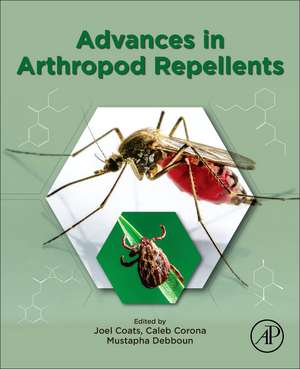Advances in Arthropod Repellents
Editat de Joel Coats, Caleb Corona, Mustapha Debbounen Limba Engleză Paperback – 19 oct 2021
This book is a valuable resource for entomologists and vector control researchers and practitioners. Public health officials and developers in private pest control companies, as well as readers in academia will find this a useful resource to learn the latest information available on controlling the spread of arthropod-borne diseases with repellents.
- Discusses recent progress on understanding how insect repellents work, as well as modern methods for finding new molecules and formulations
- Edited by a team whose expertise includes cutting-edge insect repellent research and development
- Serves as a reference and resource that will be useful to a wide variety of professionals, particularly those in public health and vector control
Preț: 673.10 lei
Preț vechi: 1095.00 lei
-39% Nou
Puncte Express: 1010
Preț estimativ în valută:
128.84€ • 139.99$ • 108.29£
128.84€ • 139.99$ • 108.29£
Carte tipărită la comandă
Livrare economică 14-28 aprilie
Preluare comenzi: 021 569.72.76
Specificații
ISBN-13: 9780323854115
ISBN-10: 0323854117
Pagini: 358
Dimensiuni: 191 x 235 mm
Greutate: 0.62 kg
Editura: ELSEVIER SCIENCE
ISBN-10: 0323854117
Pagini: 358
Dimensiuni: 191 x 235 mm
Greutate: 0.62 kg
Editura: ELSEVIER SCIENCE
Public țintă
Practitioners and researchers in entomology and vector control communitiesStudents and academics in entomology, insect physiology, chemistry, or toxicology; public health officials; private pest control companies
Cuprins
Part One: Novel Arthropod Repellent Molecule Discovery or Assay Development
1. Introduction: The Role of Arthropod Repellents in Public Health
2. Novel Pyrethroid Derivatives as Effective Mosquito Repellents and Repellent Synergists
3. Biorational Compounds as Effective Arthropod Repellents Against Mosquitoes and Ticks
4. Evaluating Techniques and Efficacy of Arthropod Repellents Against Ticks
5. Evaluation and Application of Arthropod Repellent Treated Uniform/Clothing and Textiles Against Vectors
6. Repelling Mosquitoes with Electric Fields
Part Two: Mechanism of Arthropod Repellent Research and Development
7. Multimodal Mechanisms of Repellency in Arthropods
8. Finding a Repellent Against Ticks: Neurophysiological and Behavioral Approaches
9. Arthropod Repellents and Chemosensory Reception
Part Three: Conducting Arthropod Repellent Studies in Field and Semi-field Trials
10. Semi-field Bioassays for the Evaluation of Spatial (and Topical) Arthropod Repellents for Indoor and Outdoor Use
11. Semi-field Evaluation of Arthropod Repellents: Emphasis on Spatial Repellents
12. Human Subject Studies of Arthropod Repellent Efficacy
13. Arthropod Repellent Research in Northwest Florida
Part Four: The Current Status and Future Uses of Arthropod Repellents
14. The Current Status of Spatial Repellents in the Global Vector Control Community
15. Repellent Semiochemical Solutions to Mitigate the Impacts of Global Climate Change on Arthropod Pests
16. The Role of Arthropod Repellents in the Control of Vector-Borne Diseases
1. Introduction: The Role of Arthropod Repellents in Public Health
2. Novel Pyrethroid Derivatives as Effective Mosquito Repellents and Repellent Synergists
3. Biorational Compounds as Effective Arthropod Repellents Against Mosquitoes and Ticks
4. Evaluating Techniques and Efficacy of Arthropod Repellents Against Ticks
5. Evaluation and Application of Arthropod Repellent Treated Uniform/Clothing and Textiles Against Vectors
6. Repelling Mosquitoes with Electric Fields
Part Two: Mechanism of Arthropod Repellent Research and Development
7. Multimodal Mechanisms of Repellency in Arthropods
8. Finding a Repellent Against Ticks: Neurophysiological and Behavioral Approaches
9. Arthropod Repellents and Chemosensory Reception
Part Three: Conducting Arthropod Repellent Studies in Field and Semi-field Trials
10. Semi-field Bioassays for the Evaluation of Spatial (and Topical) Arthropod Repellents for Indoor and Outdoor Use
11. Semi-field Evaluation of Arthropod Repellents: Emphasis on Spatial Repellents
12. Human Subject Studies of Arthropod Repellent Efficacy
13. Arthropod Repellent Research in Northwest Florida
Part Four: The Current Status and Future Uses of Arthropod Repellents
14. The Current Status of Spatial Repellents in the Global Vector Control Community
15. Repellent Semiochemical Solutions to Mitigate the Impacts of Global Climate Change on Arthropod Pests
16. The Role of Arthropod Repellents in the Control of Vector-Borne Diseases
